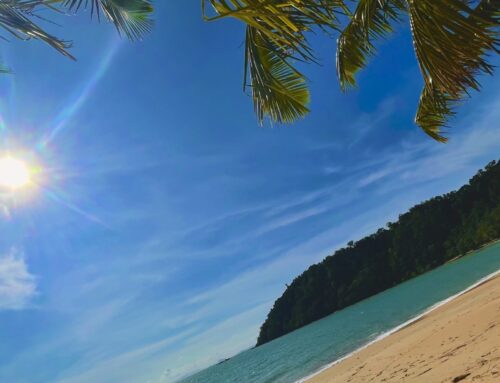Vietnam is a mesmerizing South East Asian country. Lying on the South China Sea, it is the eastern most country of the region. Vietnam boasts a huge variety of scenery, ranging from stunning rice terraces to bustling cities and idyllic beaches.
Travelling in and around Vietnam is both easy and cheap. You can follow well-trodden backpacker routes or head off the beaten track to quieter towns and villages, which are bursting with traditional culture. Following the backpacker trail does have its advantages; you’ll find reputable bus companies, good quality hostels and friendly locals (many of whom speak English) in cities from the north to the south of Vietnam.
But don’t panic, if you like to discover new territory, there are vast numbers of untouched towns and villages too.
Getting from A to B
 If you look at a map of Southeast Asia, you’ll see that Vietnam is long and thin. The most popular travel itineraries run from North to South, or South to North. Long distance coaches cover these routes, and you’ll find them to be packed with other travellers. Most big bus companies have been operating for several years and have offices in the backpacker districts of large cities, making it very easy to book a ticket for your onward journey. If you’re staying in a hostel, your hosts can also help you!
If you look at a map of Southeast Asia, you’ll see that Vietnam is long and thin. The most popular travel itineraries run from North to South, or South to North. Long distance coaches cover these routes, and you’ll find them to be packed with other travellers. Most big bus companies have been operating for several years and have offices in the backpacker districts of large cities, making it very easy to book a ticket for your onward journey. If you’re staying in a hostel, your hosts can also help you!
Two of the best long-distance bus companies include:
These companies offer comfortable coaches, with air-con, Wi-Fi and reclining seats for longer journeys. To give you an idea of price, the bus journey from Ho Chi Minh city to Nha Trang is around 220,000 VND (approx. $9.50) for a 10-hour journey.
If you’re tight on time, you may consider flying to get there quicker. It’s worth keeping an eye on flight prices anyway, as during low season, they can be just as cheap as the long-distance buses. Budget airlines, such as Vietjet, Scoot and Jetstar can reduce the 40-hour bus journey from Ho Chi Minh to Hanoi to a mere 2 hours. Beware though, these companies do also suffer frequent delays and fly at anti-social hours!
Suggested Itineraries
There are two main routes to see all of Vietnam – either from the North to the South or vice versa! The below route is South-North, but of course you can do it the other way around. We’d recommend dedicating a minimum of 2-3 weeks for this route to really make the most of it.
- Phu Quoc Island (3 days)
- Can Tho (1 day)
- Ho Chi Minh (2/3 days + Chu Chi Tunnels)
- Mui Ne (2 days)
- Dalat (2 days)
- NhaTrang (2-3 days)
- Hoi An (3 days + My Son ruins)
- Hue (2 days)
- Phong Nha National Park (2 days)
- Ninh Binh (2 days)
- Hanoi (3 days)
- Sapa (2 days)
- Halong Bay & Cat ba Island (3 days)
Where to stay?
 You’ll find dozens of hostels in each of the above cities. In peak time, it’s worth booking ahead but out of season, you’ll be able to stroll into a hostel and find a dorm bed or private room without too much hassle – though it’s probably cheaper to book in advance. Prices vary but are very reasonable; you can book dorm beds at top-rated hostels for as little as $2/3 dollars a night. Check out Booking.com or Hostelworld to find great deals.
You’ll find dozens of hostels in each of the above cities. In peak time, it’s worth booking ahead but out of season, you’ll be able to stroll into a hostel and find a dorm bed or private room without too much hassle – though it’s probably cheaper to book in advance. Prices vary but are very reasonable; you can book dorm beds at top-rated hostels for as little as $2/3 dollars a night. Check out Booking.com or Hostelworld to find great deals.
Most hostels are clean, have Wi-Fi and are safe. However, you should always remain vigilant and look after your valuables.
Crossing Land Borders
 Vietnam borders Cambodia, Laos and China. It’s easy to cross into these countries by land if you’re looking to extend your trip. The above bus companies also operate routes from Ho Chi Minh City through to Phnom Penh. There are 6 land borders which are currently open to foreigners and allow you to buy a visa upon arrival.
Vietnam borders Cambodia, Laos and China. It’s easy to cross into these countries by land if you’re looking to extend your trip. The above bus companies also operate routes from Ho Chi Minh City through to Phnom Penh. There are 6 land borders which are currently open to foreigners and allow you to buy a visa upon arrival.
For Laos, you’ll need to use the Hanoi, (Vietnam) to Luang Prabang, (Laos) border crossing route. This can be done by bus. Expect the journey to take 24-30 hours.
For China, you can cross at Lao Cai (Vietnam) to Hekou, Yunnan Province. People usually get to Lao Cai from Sapa. You’ll need a pre-arranged visa to enter China.
Cultural Considerations
Although Vietnam isn’t overly conservative, being respectful at places of worship or temple ruins is a must. Some religious sites will have dress restrictions, such as no short shorts or tank tops. If in doubt, cover up and don’t risk offending the locals!
 Don’t forget…
Don’t forget…
Vietnam is a huge country, and journeys between cities can take a long time. Unreliable road and weather conditions combined with a relatively laidback attitude towards time mean that journeys may take longer than planned. Always allow more time than the schedule says when travelling by bus or budget airline.
Also, the weather varies a lot between the north and south, especially during winter. Therefore, it’s best to check the weather in the region that you are going to, so you don’t get caught out!
Enjoy!




